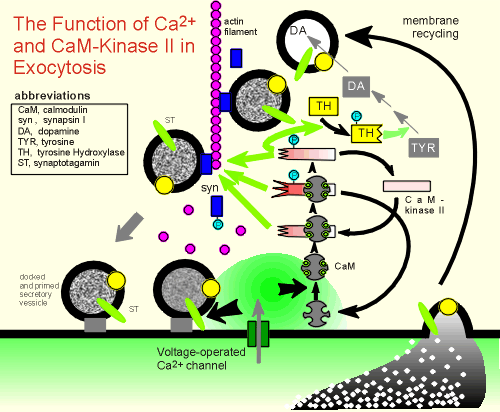 Opening of
voltage-operated Ca2+ channels creates a Ca2+ microdomain (review Ca2+ microdomains?).
Opening of
voltage-operated Ca2+ channels creates a Ca2+ microdomain (review Ca2+ microdomains?).
The long half-life of phosphorylated CaMKII has an important function in coordinating events at the membrane (Ca2+ influx and exocytosis) with functions in the interior of the cell (mobilization of secretory vesicles and biosynthesis of neurotransmitter).
The figure below shows how this occurs in a dopaminergic neuron (note that relative to the earlier representations, a very simplified representation for calmodulin and CaM-kinase II is used in this figure).
 Opening of
voltage-operated Ca2+ channels creates a Ca2+ microdomain (review Ca2+ microdomains?).
Opening of
voltage-operated Ca2+ channels creates a Ca2+ microdomain (review Ca2+ microdomains?).
If this is detected by the Ca2+ sensor protein synaptotagamin (ST) on docked secretory vesicles then exocytosis and release of dopamine occurs.
Calmodulin within the microdomain also binds Ca2+, and the Ca2+-calmodulin can now diffuse out of the microdomain to activated target proteins, including CaMK II.
More likely, the CaMK II is already phosphorylated within the microdomain.
The activated CaM-Kinase II phosphorylates the protein synapsin I, which functions as a sort of "glue" to hold a storage pool of secretory vesicles on actin filaments.
In the phosphorylated form synapsin I is no longer capable of holding the vesicles on the actin and thus the vesicles are free to be docked and primed for the next round of exocytosis.
Mobilization of secretory vesicles is occurring in the terminal long after the Ca2+ domain has disappeared and long after the calmodulin has released its Ca2+ and returned to the inactive form.
The fact that the kinase is active long after the Ca2+ signaling event has passed is useful because it can "remember" the event and prepare the terminal for the next such event.
Likewise, the kinase phosphorylates and thus activates tyrosine hydroxylase (TH), the rate limiting enzyme in the synthesis of dopamine.
Thus, it is responsible for producing new neurotransmitter to fill the recycled secretory vesicle (which will subsequently be stored on actin filaments via synapsin I binding).
The kinase is also known to activate the pump (yellow circle) responsible for pumping the dopamine into the vesicle.
Thus an event at the membrane, Ca2+ influx and exocytosis, is remembered long after it occurred and work is being done deep in the cell to prepare for the next event.